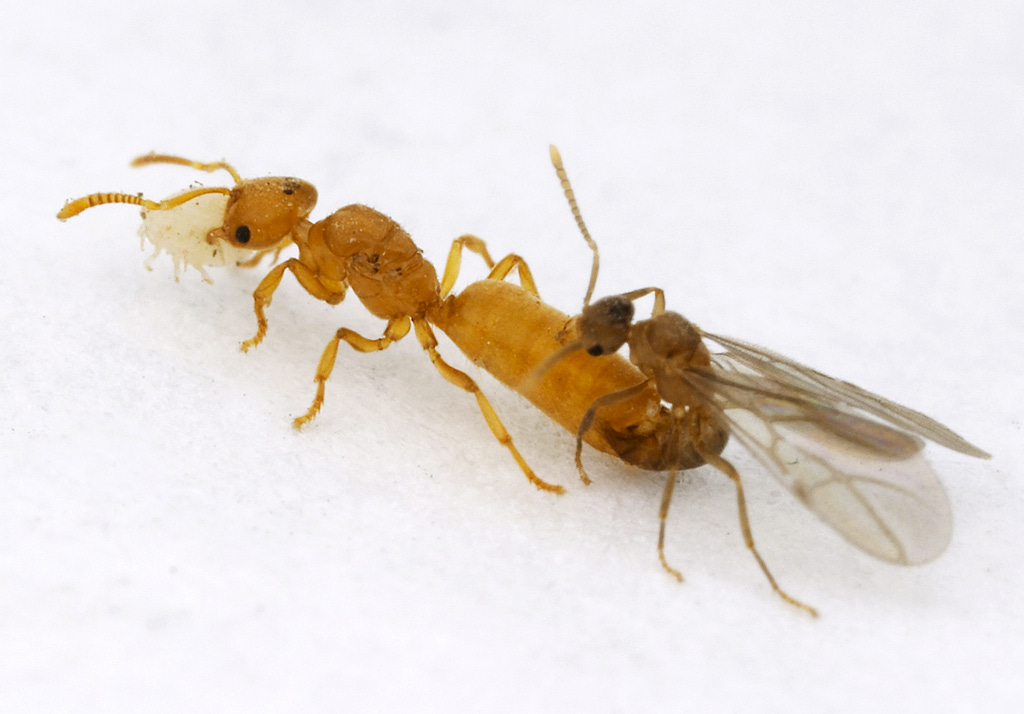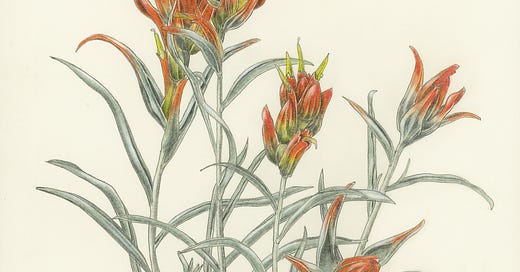During AntCourse in the Chiracahua Mountains one summer, I tired of watching students gluing tiny ants to tiny paper triangles on pins and headed for a walk up Herb Martyr Road. Beyond the cattle guard and the sentinel juniper was a grassy, bouldered slope with a dense stand of Indian paintbrush. Paintbrush is another fine example of something that looks like a flower, but isn't, for most of the color in the red heads is actually a set of bracts, and the real flowers are slender greenish things poking out from among the bracts. The flowers are edible, but when the soil contains selenium, the plants become mildly toxic, so you had better not eat too much. Paintbrush is reputed to be a root semi-parasite on other plants, and as the afternoon faded, I sat on a boulder and pondered what semi might mean in this context, and whose roots the paintbrush might be semi-sucking nourishment from.
Little tiny insects were flying past my face, and I assumed they were midges from the creek below, until I noticed that they emanated in large numbers from beneath a rock nearby. I swatted a few out of the air, and discovered to my delight that they were virgin queens of Acropyga epedana, pale and flimsy, embarking on their nuptial flight. I was familiar with the Acropyga story, that these little ants almost never show themselves above ground, and are rarely collected. They herd mealybug "cows" that suck nourishment from the roots of plants underground, and excrete the excess sugars as “honeydew” (sweet feces, to be frank) for the ants to eat. Like Masai herdsmen who live on milk and cow's blood, the colony is totally dependent on this mealybug honeydew, perhaps occasionally killing and feeding one of the "calves" to their larvae. The mealybugs, in their turn, are all female and reproduce pathenogenetically (i.e. asexually). They are therefore a clone, all genetically identical, totally dependent on the ants for their maintenance. As a result, the fates of colonies and their mealybug clones are one and the same, functioning like a single organism.
But like most ants, Acropyga inherited its life cycle from the ancient ancestor of all ants—- new colonies are started by newly mated queens, alone and without the aid of workers. But how would this work when the success of a new colony depends completely on the mealybugs that workers own and tend like livestock. So, how is the new colony to acquire its own herd when the workers do not accompany the queen during colony founding?


As I watched, the queen hopefuls became airborne by the hundreds, and from those in my hand, I saw how they had solved the problem of propagating their herds during colony founding. Each queen had a mealybug firmly clamped between her mandibles. Because mealy bugs reproduce by parthenogenesis, a single mealybug can start a new herd of identical offspring. The queen hangs onto this starter-herd of livestock even during mating as though her life depended on it (which it does). So tight is this grip that museum specimens of Acropyga queens commonly retain the mealybugs between their mandibles. Indeed, this has been going on for millions of years—- the queen below was encased in Dominican amber 20 million-years ago, and still clamps the mealybug in a death grip.

Once ensconced in her newly excavated underground nest, the queen places the mealybug on the root of a plant, temporarily becoming a herder nurturing her future cattle herd. At the same time, she produces her first little group of workers in part from her body reserves and in part from the contributions of her new mealybug colony. If she succeeds, the workers take over, and the queen tends to the only business that is hers and hers alone---- laying eggs.

Sitting upon that boulder, I reflected that both Acropyga and paintbrush are root parasites, one directly, the other indirectly through their mealybugs. The question of what is a semi parasite came floating back. If the Acropyga mealybugs were living directly on the roots of paintbrush, would this be a holo-semi-parasitic relationship? Would feeding by the holo-root-parasite affect the semi-host of paintbrush? And would it be any more advisable for the holoparasitic mealybugs on the semi-parasitic paintbrush to eat selenium-laced paintbrush than it is for us?




Holo Cow, Antman!
ok, I'm swearing off mealybugs!! what about sow bugs?